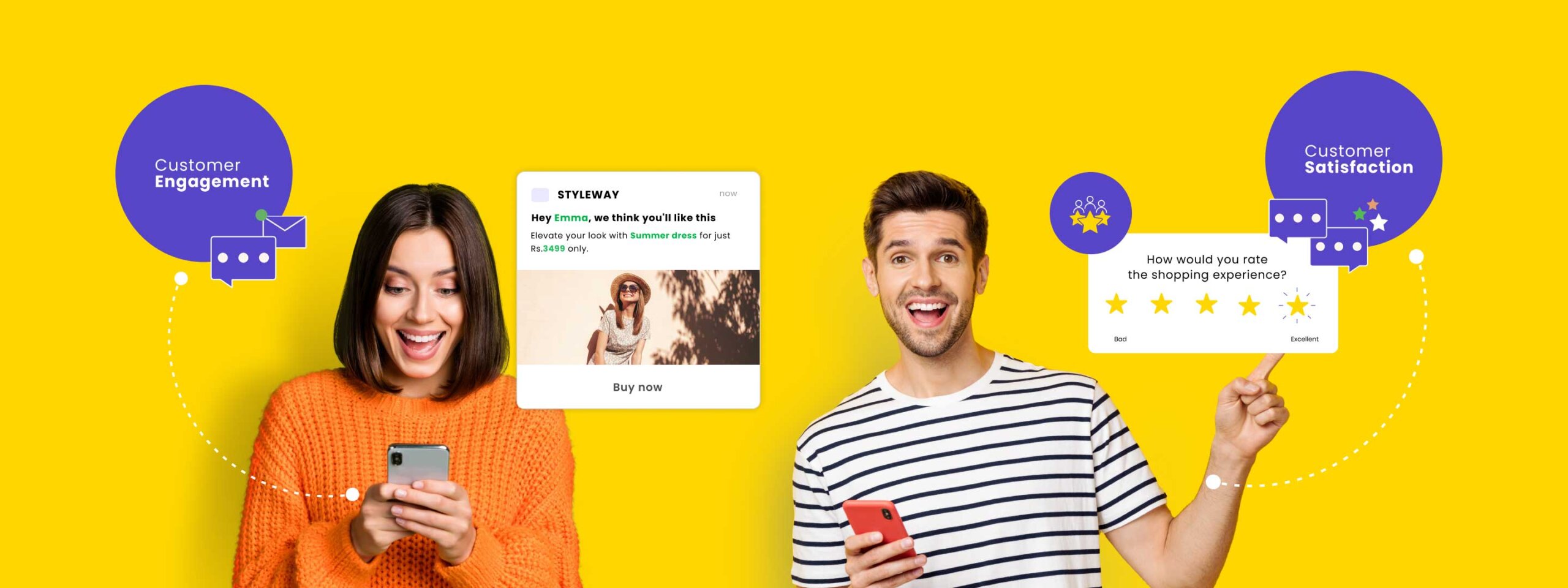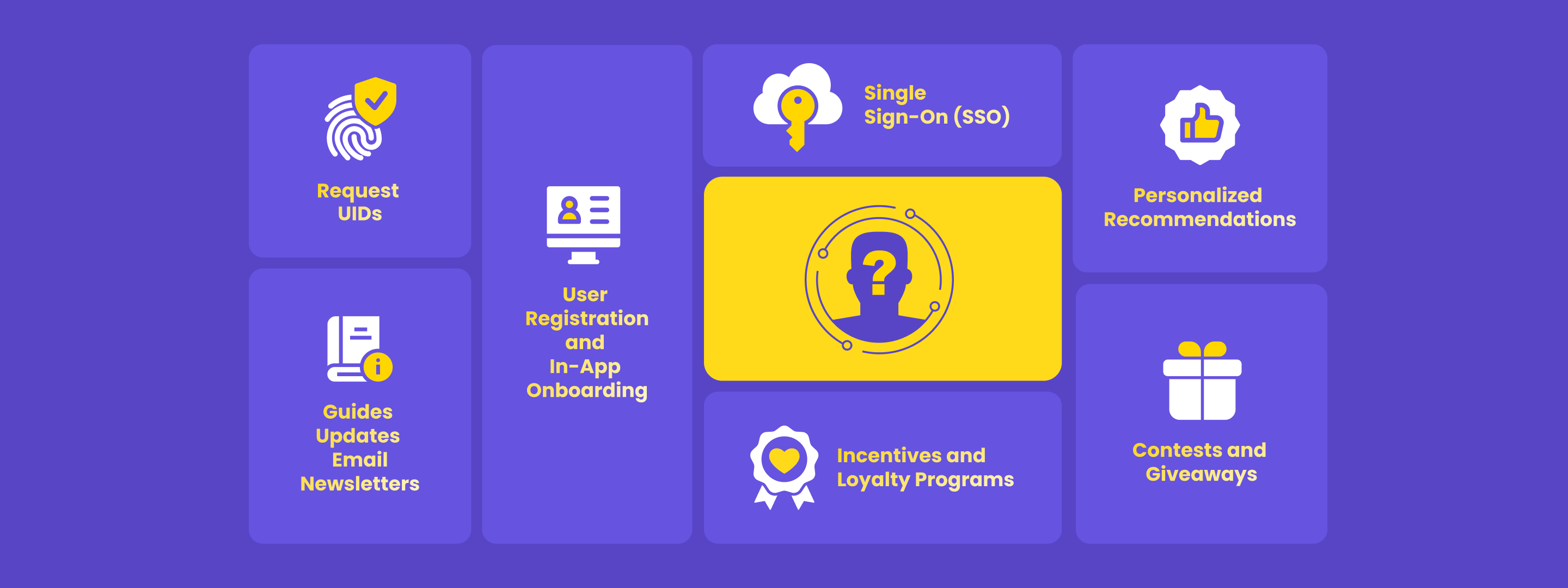Improving customer engagement & relationships is on every company’s agenda, irrespective of their industry. Because more and more brands are looking to optimize their existing customer-involving processes than work toward customer acquisition alone.
Two such processes are customer engagement and customer satisfaction. But the reality is both are often thrown around without understanding their definitions and are sometimes used interchangeably.
Customer engagement and satisfaction indicate a different measure of the relationship between a business and its customer. Customer engagement aims to interact with your users and helps measure the number of successful conversions, purchase frequency, etc. While customer satisfaction is a measurement of the customer’s experience and how well their needs are being met.
This article deeply explores the two measurements and helps you understand their differences.
Customer engagement vs Customer satisfaction
What is customer engagement, and why is it important?
Your customer’s journey and relationship with your brand do not abruptly end as soon as a transaction ends. You must nurture it and ensure to build a long-term bond. That’s what customer engagement aims for.
Customer engagement is refining a business’s and its customers’ relationship through varied interactions and engagement methods. In short, customer engagement is a non-stop process that lets you increase profits through customer loyalty.
Why is it important?
Strategic customer engagement is the driving force behind your customers’ purchasing decisions. It aims to increase customer loyalty toward your brand and products or services, as the core of engagement is personalization.
Excelling at personalization is known to generate 40% more revenue for most companies. Each customer interaction, when hyper-personalized, leads to more conversions and rapid buyer cycles and opens up up-sell and cross-sell opportunities.
An increase in sales velocity is the biggest plus of customer engagement. Creating a positive customer-brand experience, valuable interactions, and personalized touchpoints transforms your sales funnel and guides your customer rapidly through it.
Examples of customer engagement
1. Perfora — Personalized communication across all customer interaction channels
Perfora is a prime example of how you can engage and retain your customers using the right engagement strategies despite being brand new in the oral care industry.
What worked?
Created an omnichannel communication approach across multiple channels, such as email, WhatsApp, SMS, and Web Push. Next, the company identified users that abandoned carts for more than 15 minutes and sent personalized communication across all touchpoints to boost engagement. As a result, Perfora noticed a 13% cart abandonment recovery rate within a seven-month period.
2. Farmers Fresh Zone — Increase in repeat purchases
Farmers Fresh Zone, as an agritech D2C company, aimed to improve wellness standards and the health of its consumers by engaging with them in real time.
What worked?
The company used WebEngage’s solutions to nudge and engage users based on their past actions, the number of app uninstalls, and cart abandonments. Based on this data, they offered highly customized user experiences through tailored, contextual communication. Ultimately, the company saw a spike in repeat orders by 40% and revenue by about 25%.
3. Scripbox — Increase in email open rates by 30%
The leading digital wealth manager, Scripbox, looked to drive better user engagement and retention without spamming its users with multiple notifications.
What worked?
Scripbox automated its engagement strategies and used analytics to gain direct insights into understanding consumer behavior. The company used user segmentation to send hyper-targeted contextual communication to ensure the right message reaches the right audience.
Additionally, Scripbox engaged its users with rich media and personalization elements to avoid the risk of spamming them. As a result, the company achieved a 3x rise in user engagement and growth in email open rates.
4. Pickyourtrail — Automated traveler engagement
Pickyourtrail found sending event-based communication to its travelers challenging and looked to improve traveler retention.
What worked?
Smoothened the existing engagement processes by understanding travelers’ behavior and micro-targeted travelers based on their preferences. Using this, the company could send highly contextual travel information and deals to its travelers through email and SMS channels. As a result, PYT witnessed a 50% increase in overall traveler engagement.

How to measure customer engagement
Here are some essential metrics every company optimizing their customer engagement tactics must be measuring:
1. Net promoter score (NPS)
NPS is measured through surveys and indicates customers’ loyalty to your products or services and their willingness to recommend your business to others.
NPS sets a benchmark in customer experience and can be calculated using a simple survey question. For instance, “On a scale of 0 to 10, how likely are you to recommend our product to your family or friends?” — a sum of your customers’ responses gives you an accurate NPS.
2. Churn rate
The churn rate indicates the percentage of customers your business lost over a period. This measure can give you an idea of possible customer dissatisfaction and disengagement with your business.
To measure the churn rate, divide the number of customers lost over a period by the number of customers active at the beginning.
3. User actions
You can measure customer engagement through certain actions your users tend to take on your website. For instance, the number of clicks, site visits, abandoned carts, time spent on the website, etc.
4. Frequency of page visits
Analyzing your website traffic can help you understand the effectiveness of your customer engagement tactics. You can measure the number of repeated visits along with the time spent on your page.
5. Conversion and bounce rates
Measure user conversions, i.e., number of purchases, downloads, app installs, etc. Similarly, measure the bounce rate — the percentage of visitors exiting your site without taking any action.
Low conversion and high bounce rates call for honing your customer engagement measures.
What is customer satisfaction, and why is it important?
Meeting your customers’ evolving needs increases customer lifetime value and retention. Customer satisfaction, or CSAT, measures how well your business and products or services match your customer’s expectations. It’s a prime indicator of your brand’s health.
Why is it important?
Customer satisfaction helps you fix user problems from the source and builds a strong brand reputation. Here are some more benefits of positive customer satisfaction:
- Satisfied customers mean a reduced churn rate. When you satisfy your customers by listening to their needs and letting them resonate with your offering, you ensure they do not look elsewhere for options.
- Happy customers turn into loyal brand advocates and boost new customer acquisition. They are more likely to recommend your business to others.
- Increases customer lifetime value as satisfied customers tend to spend more on brands they are happy with. Forbes suggests customers spend 140% more with brands that offer great experiences.
Examples of customer satisfaction
1. Angel One — Contextual surveys
Angel One, a leading stock broker firm, found understanding users’ preferences and behavior challenging.
What changed?
Angel One implemented WebEngage’s on-site form surveys to deliver contextual surveys to users on pressing questions and offered discounts. For instance:
- Did you find our service helpful?
- What do you love most about our product?
- How likely are you to recommend our retain stockbroker solutions to your friends or family?
Such survey questions paired with rich media helped the company attract more leads and encouraged users to open an account.
2. Vikatan — Customer feedback surveys
Vikatan is a popular Tamil language-based media house and serves over 30 million users across the globe.
The company had noticed a drop in users and faced a lack of app install data for analyzing trends.
What changed?
Vikatan wanted to understand the root cause of many app uninstalls. So the company reached out to users who uninstalled the app through a feedback survey. After running the survey, the company found that most users uninstalled the app after it crashed on their devices.
Vikatan then suggested the responded users upgrade the app to continue consuming their content. And as a result of this survey, over 18% of users successfully reinstalled the Vikatan app on their mobile.
3. Snapp! — Measuring user satisfaction
Snapp!, a vehicle-hiring company, offers services ranging from booking cabs to hotel rooms, ordering food, and more. And the major challenge faced was keeping track of users’ app actions and measuring satisfaction.
What changed?
Snapp’s marketing team collected riders’ feedback to analyze and offer them a better app and ride experience. The company used WebEngage’s Transactional Campaign API to trigger messages and run targeted surveys in real-time and encouraged riders to share their valuable feedback.
As a result, the company noticed a staggering 60% average survey response rate.

How to measure customer satisfaction
Here are four key metrics that help you measure customer satisfaction to make important business decisions:
1. Customer Satisfaction Score (CSAT)
CSAT helps you measure overall satisfaction based on a scoring system. CSAT surveys are sent after a customer interacts or purchases with your business.
Measuring CSAT at scale requires you to send targeted surveys with questions and scores. For instance, 1 is ‘extremely dissatisfied,’ and 5 is ‘highly satisfied’.

2. Loyalty measurement using Net Promoter Score (NPS)
Loyalty has a direct correlation with customers’ overall satisfaction with your offering. Measuring NPS and loyalty lets you understand their likelihood of repurchasing or recommending your products or services.
Some example loyalty survey questions are:
- Overall, how satisfied are you with our business?
- How likely are you to recommend your purchased product?
- How likely are you to continue buying with our brand?
3. Attitude satisfaction measurement
Understanding your customers ‘attitudes’ toward your products or services is essential in measuring satisfaction. It also lets you analyze your customers’ points of view and tailor your offerings to resonate with them.
Some sample questions you could include to measure this way are:
- How satisfied are you with our product’s quality?
- Did our product meet or exceed your initial expectations?
4. Repurchase measurement
Measuring the repurchase intention is a behavioral customer satisfaction metric that lets you understand user preferences and buying tendencies. Good customer experience largely influences the number of repurchases made through your business.
An example question to measure this metric is – ‘Do you intend to return to x company within the next 30 days?’
Customer engagement vs. customer satisfaction: Summary
Since customer engagement and customer satisfaction tend to be misunderstood by many brands, the below table puts an end to this confusion:

But what connects both these strategies?
Customer engagement and customer satisfaction are indeed counterparts. Meaning customer engagement ultimately drives customer satisfaction to let you achieve business outcomes.
Pro tip: Use customer engagement to drive customer satisfaction
Having more customers engaged leads to healthier customer satisfaction in the long run. Not just this, but when you focus more on your engagement strategies, you build customers’ trust and retain them more effectively.
Customer support interactions are great examples of engagement driving satisfaction. For instance, a consumer is on your site looking for sizing help that’s stopping them from finishing the transaction. In such a case, timely engagement in offering service turns them into happy, satisfied customers.
So ultimately, using both customer engagement and satisfaction side by side leads to better retention rates.
Conclusion
As we’ve understood from this article, customer engagement and customer satisfaction are not mutually exclusive. They address different parts of the customer journey; hence, you need both to achieve higher retention rates and reduce churn.
And customer experience (CX) is integral to building a business growth strategy that considers both customer engagement and satisfaction throughout the customer lifecycle. This is possible when your business designs customer journeys from start to finish.
Interested to learn more?


































 Kasturi Patra
Kasturi Patra

 Dev Iyer
Dev Iyer



